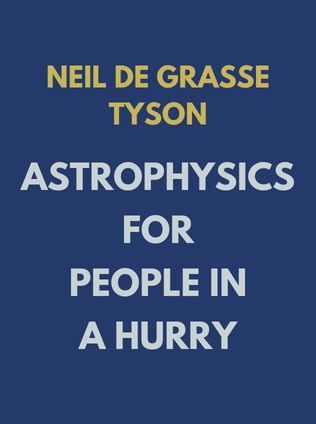
Astrophysics for People in a Hurry
By Neil de Grasse Tyson
Published 05/2017
About the Author
Neil deGrasse Tyson is a name synonymous with the popularization of science. Born on October 5, 1958, in New York City, Tyson has dedicated his life to exploring the cosmos and bringing that exploration to the public. He is an astrophysicist, author, and science communicator, known for his ability to simplify complex scientific concepts. His career is highlighted by his role as the director of the Hayden Planetarium at the American Museum of Natural History and as the host of the radio show and podcast StarTalk. Tyson’s work has earned him widespread recognition, including the Public Welfare Medal from the National Academy of Sciences. His ability to inspire curiosity about the universe and make science accessible to a broad audience has made him a pivotal figure in the world of science communication.
Tyson has written several books, but perhaps none has resonated as deeply with the general public as Astrophysics for People in a Hurry. This book distills complex topics in astrophysics into bite-sized chapters, offering readers a glimpse into the workings of the universe without requiring a Ph.D. in physics. Through his books, television appearances, and lectures, Tyson continues to carry the torch of popular science, following in the footsteps of Carl Sagan, his predecessor in making the wonders of the universe accessible to everyone.
Main Idea
Astrophysics for People in a Hurry is designed to bring the vast, often overwhelming, concepts of astrophysics down to earth. Neil deGrasse Tyson expertly condenses the key ideas of the universe’s origin, the forces that shape it, and the mysteries that continue to baffle scientists, into a format that is both engaging and comprehensible. The main idea of the book is to offer readers a perspective that stretches beyond our daily concerns, revealing how astrophysics can reshape our understanding of our place in the cosmos. Through this lens, Tyson encourages us to think beyond the confines of our world and to appreciate the beauty and complexity of the universe.
Table of Contents
- Why Study Astrophysics?
- The Basic Assumptions of Science
- The Full Spectrum of Light
- The Big Bang
- Dark Matter
- Dark Energy
- The Current Frontier
Why Study Astrophysics?
Astrophysics might seem distant from our daily lives, but as Tyson argues, it holds the key to understanding our place in the universe. From the moment humans first looked up at the stars, we have been driven by a desire to comprehend the cosmos. Astrophysics, the study of the physical properties and processes of celestial objects, offers answers to some of the most profound questions about existence: Where did we come from? What is the nature of reality? How do we fit into the grand scheme of things?
One of the central themes Tyson explores is the idea that astrophysics provides a humbling perspective. Throughout history, humanity has repeatedly been dislodged from the center of the universe. The Copernican revolution showed that the Earth was not the center of the solar system, and later discoveries revealed that our solar system is just one of billions within the Milky Way, which itself is just one of countless galaxies. The universe is vast, and our place in it is tiny, but this realization is not disheartening. Instead, Tyson suggests that it should inspire us to cherish our world and recognize the triviality of our differences when viewed against the backdrop of the cosmos.
"The study of astrophysics is important because it teaches perspective and humility. When we ponder the vastness of the universe and how tiny our place is within it, we realize how trivial our differences are and how much we should value this one world we have."
—Neil deGrasse Tyson
Astrophysics, therefore, is not just about understanding stars, galaxies, or the Big Bang; it is about understanding ourselves and our shared humanity. By looking out into the universe, we gain insight into the forces that govern everything from the smallest atom to the largest galaxy, and in doing so, we gain a new appreciation for the delicate balance that sustains life on Earth.
the Humbling Effect of Astrophysics:
- Realizing that Earth is not the center of the universe, but a small planet orbiting an average star in the Milky Way.
- Understanding that our galaxy, the Milky Way, is just one of billions of galaxies in the observable universe.
- Contemplating the possibility of multiverses, where our universe might be just one of many, each with its own laws of physics.
- Recognizing that the elements in our bodies were forged in the nuclear furnaces of stars that lived and died billions of years ago.
The Basic Assumptions of Science
At the heart of all scientific inquiry are a few fundamental assumptions that guide our understanding of the universe. Tyson highlights two critical assumptions in astrophysics: the universality of physical laws and the constancy of these laws over time. These principles form the foundation upon which the edifice of modern science is built.
The first assumption is that the laws of physics are the same everywhere in the universe. Whether we are studying the behavior of atoms in a laboratory on Earth or observing the motion of stars in distant galaxies, the same principles apply. This universality is a cornerstone of science, allowing us to make predictions and build theories that can be tested and verified through observation and experimentation.
The second assumption is that these laws do not change over time. The same forces that governed the formation of the universe billions of years ago are at work today. By observing distant galaxies, which are essentially looking back in time due to the finite speed of light, we can confirm that the fundamental laws of physics have remained consistent throughout the history of the universe.
"Science is a process that helps us zero in on objective reality while systematically eliminating our preconceptions."
—Neil deGrasse Tyson
However, science is not static. It evolves as new evidence comes to light and as old theories are refined or replaced. Tyson discusses how scientific revolutions occur when new discoveries force us to rethink our understanding of the universe. For example, Isaac Newton’s laws of motion and gravitation were once considered complete descriptions of physical reality. However, the advent of Einstein’s theory of general relativity revealed that Newton’s laws were just approximations, valid under certain conditions but not universally applicable.
Sign up for FREE and get access to 1,400+ books summaries.
You May Also Like
Factfulness
Ten Reasons We're Wrong About the World – and Why Things Are Better Than You Think
By Hans RoslingBraiding Sweetgrass
Indigenous Wisdom, Scientific Knowledge and the Teachings of Plants
By Robin Wall Kimmerer



















